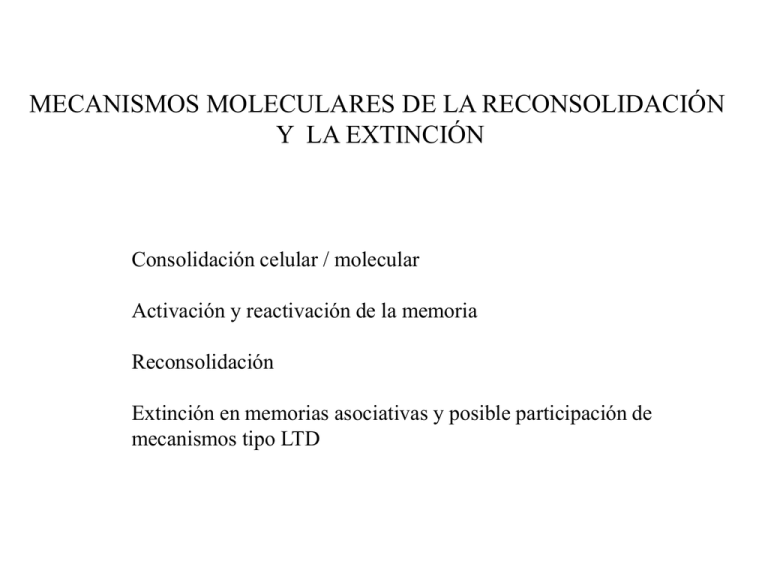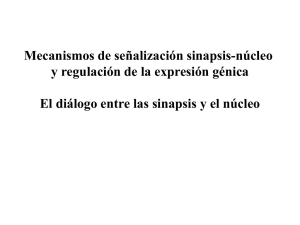Mecanismos de reconsolidación y extinción.pdf
Anuncio

MECANISMOS MOLECULARES DE LA RECONSOLIDACIÓN Y LA EXTINCIÓN Consolidación celular / molecular Activación y reactivación de la memoria Reconsolidación Extinción en memorias asociativas y posible participación de mecanismos tipo LTD Contextual memory retieval may induce either RECONSOLIDATION or EXTINCTION depending on the length of context re-exposure Behavioral output Retrieval by short reexposure (5 min) Retrieval by prolonged reexposure (30 min) reconsolidation extinction Original memory Extinction memory Testing session Untrained or Amnesic Animal Trained Animal La extinción is una inhibición temporaria del comportamiento de freezing La recuperación expontánea ocurre algunos días después Miedo Condicionado (fear conditioning) Tanto la reconsolidación como la extinción dependen de la síntesis de novo de proteínas durante un período crítico Contextual fear conditioning Inyección de anisomicina Suzuki et al., 2004 Tanto la reconsolidación como la extinción dependen de la síntesis de novo de proteínas durante un período crítico Contextual fear conditioning Inyección de anisomicina Suzuki et al., 2004 Reconsolidación: ¿Cómo se labiliza la memoria reactivada? ¿Cómo se re-estabiliza? Extinción: ¿La consolidación de la extinción es un proceso igual o similar al de la memoria original? ¿Es un nuevo circuito que inhibe temporariamente la expresión del original? ¿Es un debilitamiento temporario del mismo circuito? ¿Ambas cosas? ¿Cuál es el mecanismo que determina si la memoria va a reconsolidación o extinción después de la evocación? 1- NF-kB en la consolidación Curso temporal de la actividad de NF-kB en el hipocampo durante la consolidación NF-B Inhibition by B Decoy DNA Intrahipocampal injection of ds DNA oligonucleotide containing the NF-B consensus sequence : B Decoy : 5’-GAGGGGACTTTCCCA-3’ -CTCCCCTGAAAGGGTmutated B Decoy : 5’-GAGGCGACTTTCCCA-3’ -CTCCGCTGAAAGGGT- Fluorescein - B Decoy entra en las neuronas 15 min después de la inyeción B Decoy, pero no mDecoy, inhibe NF-B Boccia et al., J. Neurosci., 2007 La inhibición de NF-B en el hipocampo impide la consolidation de la memoria 2- NF-kB en la reconsolidación Actividad de NF-B durante la reconsolidación *** * de la Fuente et al, J. Neurosci. 2011 R La inhibición de NF-B en el hipocampo impide la reconsolidación de la Fuente et al, J. Neurosci. 2011 NoR La inhibición de NF-kB no impide la “short-term reactivated memory” 3- NF-kB en la extinción La inhibición de NF-B en el hipocampo retarda la recuperación expontánea E NoE de la Fuente et al, J. Neurosci. 2011 Curso temporal de la actividad de NF-B en el hipocampo durante y después de la extinción de la Fuente et al, J. Neurosci. 2011 Evidencias previas sugieren que la fosfatasa calcineurina está involucrada en la extinción La calcineurina es activada por Ca2+ - Calmodulina P Phosphatase activity La calcineurina está presente en espinas dendriticas Evidencias previas Evidencias previas Lin et al., J. Neurosci., 2003 Postulamos que calcineurina está involucrada en el hipocampo en la memoria de extinción La inhibición de calcineurina por el FK506 impide la extinción E NoE de la Fuente et al, J. Neurosci. 2011 La inhibición de calcineurina no impide la reconsolidación Hipothesis: durante la re-exposición prolongada (extinction) la calcineurina es activada y bloquea la activación de NF-B La inhibición de calcineurina permite la activación de NF-B después de la extinción (como si fuera reconsolidación) de la Fuente et al, J. Neurosci. 2011 Hay un target nuclear de calcineurina para la memoria de extinción? Calcineurin – NFAT pathway NFAT es un factor de transcripción evolutivamente relacionado with NF-B La inhibición de NFAT impide la extinción E NoE de la Fuente et al, J. Neurosci. 2011 La inhibición de NFAT no impide la reconsolidación Calcineurin y NFAT translocan al nucleo 45 min después de la sesión de extinction de la Fuente et al, J. Neurosci. 2011 La inhibición de calcineurina impide la translocación de NFAT FK/DMSO de la Fuente et al, J. Neurosci. 2011 Transcription factor switch between reconsolidation and extinction The transcription factor NF-kB is activated 15 min after a brief reexposure to the training context, and induces its target genes expression. This brief stimulus leads to reconsolidation. In contrast, if the stimulus is prolonged, phosphatase CaN is activated and blocks NF-kB activation. CaN also activates NFAT transcription factor by direct dephosphorylation. This, in turn, would activate its target genes expression. CaN and NFAT translocate to the nucleus as a complex, thus impeding the NFAT rephosphorylation. In this case, extinction of memory takes place. Reconsolidation and extinction are dissociable and mutually exclusive processes: behavioral and molecular evidence. Merlo E1, Milton AL, Goozée ZY, Theobald DE, Everitt BJ. J. Neurosci 2014 At training, rats received two CS–US pairings. Twenty-four hours later, the animals were re-exposed to 1 or 10 CSs to reactivate or extinguish the fear memory (n = 8 per group). The following day at the retention test, all the animals were presented with one CS.C, The same behavioral procedure , but with the inclusion of a non-reactivated Ctr group that was trained identically to the 1CS and 10CS groups but during the re-exposure session remained in the home cage. Twenty (pERK1/2) or 60 (CaN) minutes after re-exposure, or straight from the home cage (Ctr groups), animals were killed and the cytoplasmic protein extracts from the BLA obtained (all groups, n= 8). D, E, Representative Western blot results and analysis showing the cytosolic levels of pERK1/2 (D) or CaN (E) after 1 or 10 CS presentations. Data are presented as means ± SEM. *p < 0.05, **p < 0.01. Reconsolidation and extinction are dissociable and mutually exclusive processes: behavioral and molecular evidence. Merlo E1, Milton AL, Goozée ZY, Theobald DE, Everitt BJ. J. Neurosci 2014 A CaN increase induced by 10 CSs is required for consolidation of the fear extinction memory. A, Animals with fully consolidated fear memory received microinfusions of ASO or Scr ODN sequences in the BLA (see Fig. 2) 2.5 h before the presentation of 1 CS (n = 10 per group) or 10 CSs (Scr ODN, n = 10; ASO, n = 8). Four days later, all groups were tested for long-term fear or extinction memory retention by the presentation of one CS. *p < 0.005. B, Animals with fully consolidated fear memory were microinfused with ASO (n = 5) or Scr ODN (n = 4) 2.5 h before 10 CS presentations. One hour after the 10 CS presentations, they were killed and the BLA cytoplasmic extract was obtained. A representative result of the Western blot analysis along with the quantification of CaN levels in the BLA is shown. Data are presented as means ± SEM. *p < 0.05. Reconsolidation and extinction are dissociable and mutually exclusive processes: behavioral and molecular evidence. Merlo E1, Milton AL, Goozée ZY, Theobald DE, Everitt BJ. J. Neurosci 2014 NMDAR agonist and antagonist treatments differentially affect the behavioral transition between reconsolidation and extinction. A, Experimental design. One day after training, the rats received an intraperitoneal injection of the NMDAR partial agonist DCS (15 mg/kg) or the antagonist MK-801 (0.1 mg/kg). B–E, One quarter of each group received 1 CS (B), 4 CS (C), 7 CS (D), or 10 CS (E) presentations (line graphs). Twenty-four hours later, freezing behavior was measured in all groups by the presentation of one CS (bar graphs). Data are presented as means ± SEM. MK-801 groups: 1 CS, n = 12; 4 CSs, n = 9; 7 CSs, n = 9; and 10 CSs, n = 11. DCS groups: 1 CS, n = 7; 4 CSs, n = 8; 7 CS, n = 8; and 10 CSs, n = 8. *p < 0.05, **p < 0.01. Models of the transition from reconsolidation to extinction of fear memories. A, Gradual model. B, Step function model. C, Three-phase model. R, Reconsolidation process; E, extinction process; y-axis, sensitivity to NMDAR activity manipulations; x-axis, number of CS presentations.
